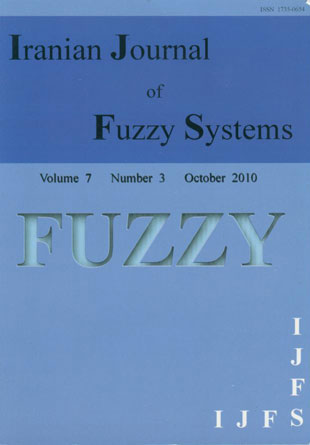فهرست مطالب

Iranian journal of fuzzy systems
Volume:7 Issue: 3, Oct 2010
- تاریخ انتشار: 1389/08/01
- تعداد عناوین: 9
-
-
Pages 1-13Numerous algorithms have been proposed to solve the shortestpath problem; many of them consider a single-mode network, crisp costs. Other attempts have addressed the problem of fuzzy costs in a single-mode network, the so-called fuzzy shortest-path problem (FSPP). The main contribution of the present work is to solve the optimum path problem in a multimodal transportation network, in which the costs of the arcs are fuzzy values. Metropolitan transportation systems are multimodal in that they usually contain multiple modes, such as bus, metro,, monorail. The proposed algorithm is based on the path algebra, dioid of k-shortest fuzzy paths. The approach considers the number of mode changes, the correct order of the modes used,, the modeling of two-way paths. An advantage of the method is that there is no restriction on the number, variety of the services to be considered. To track the algorithm step by step, it is applied to a pseudo-multimodal network.
-
Pages 15-32Due to the explosive growth of the world-wide web, automatic text summarization has become an essential tool for web users. In this pa- per, we present a novel approach for creating text summaries. Using fuzzy logic, word-net, our model extracts the most relevant sentences from an original document. The approach utilizes fuzzy measures, inference on the extracted textual information from the document to find the most significant sentences. Experimental results reveal that the proposed approach extracts the most relevant sentences when compared to other commercially available text summarizers. Text pre-processing based on word-net, fuzzy analysis is the main part of our work.
-
Pages 33-50In this paper difference methods to solve «fuzzy partial differential equations» (FPDE) such as fuzzy hyperbolic, fuzzy parabolic equations are considered. The existence of the solution, stability of the method are examined in detail. Finally examples are presented to show that the Hausdorff distance between the exact solution, approximate solution tends to zero.
-
Pages 51-71In this paper, we study the finitely many constraints of the fuzzy relation inequality problem, optimize the linear objective function on the region defined by the fuzzy max-product operator. Simplification operations have been given to accelerate the resolution of the problem by removing the components having no effect on the solution process. Also, an algorithm, some numerical, applied examples are presented to abbreviate, illustrate the steps of the problem resolution.
-
Pages 73-86We prove a related fixed point theorem for n mappings which are not necessarily continuous in n fuzzy metric spaces using an implicit relation one of them is a sequentially compact fuzzy metric space which generalize results of Aliouche, et al. [2], Rao et al. [14], [15].
-
Pages 87-96The main purpose of this paper is to consider the t-best simultaneous approximation in fuzzy normed spaces. We develop the theory of t-best simultaneous approximation in quotient spaces. Then, we discuss the relationship in t-proximinality, t-Chebyshevity of a given space, its quotient space.
-
Pages 97-113The aim of this paper is the study of fuzzy basis, dimension of fuzzy hypervector spaces. In this regard, first the notions of fuzzy linear independence, fuzzy basis are introduced, then some related results are obtained. In particular, it is shown that for a large class of fuzzy hypervector space the fuzzy basis exist. Finally, dimension of a fuzzy hypervector space is defined, the basic properties of that are investigated.
-
Pages 115-128In this paper, we introduce, study the prime, strongly prime, semiprime, irreducible fuzzy bi-ideals of a semigroup. We characterize those semigroups for which each fuzzy bi-ideal is semiprime. We also characterize those semigroups for which each fuzzy bi-ideal is strongly prime.
-
Pages 129-157In the present paper we define the notion of fuzzy inner product, study the properties of the corresponding fuzzy norm. In particular, it is shown that the Cauchy-Schwarz inequality holds. Moreover, it is proved that every such fuzzy inner product space can be imbedded in a complete one, that every subspace of a fuzzy Hilbert space has a complementary subspace. Finally, the notions of fuzzy boundedness, operator norm are introduced, the relationship between continuity, boundedness are investigated. It is shown also that the space of all fuzzy bounded operators is complete.

